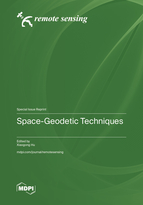Space-Geodetic Techniques
A special issue of Remote Sensing (ISSN 2072-4292). This special issue belongs to the section "Satellite Missions for Earth and Planetary Exploration".
Deadline for manuscript submissions: closed (15 August 2022) | Viewed by 41456
Special Issue Editor
Interests: astronomy; orbit determination; spacecraft
Special Issues, Collections and Topics in MDPI journals
Special Issue Information
Dear Colleagues,
In the past several decades, space-geodetic techniques such as very long baseline interferometry (VLBI), Global Navigation Satellite Systems (GNSS), satellite laser ranging (SLR), interferometric synthetic aperture radar (InSAR), Doppler orbitography and radio-positioning integrated by satellite (DORIS), and satellite altimetry and gravimetry, etc., have played an increasingly significant role in Earth exploration and geodetic research. Benefiting from the rapid development of satellite techniques and the creation of ground/space-based observing systems , the establishment and maintenance of the Earth’s reference frame, the Earth’s rotation and geodynamics, navigation and positioning in high precision, gravity fields, geodetic observation, and the remote sensing and modeling of the Earth’s atmosphere and ionosphere, as well as deep space exploration, are facilitated with more accurate and dense data and are attracting more and more attention to solve challenging scientific problems.
This Special Issue aims at studies covering different applications of Space-Geodetic Techniques in space and ground observations in Earth sciences. The topics may cover anything from the classical estimation of Earth observation at high precision, to more comprehensive aims and scales. Hence, multisource data integration, multiscale approaches or studies focused on Earth monitoring, among other issues, are welcome. Articles may address, but are not limited to, the topics as listed subsequently.
- Global and regional gravity field modeling;
- Satellite gravimetry and applications in global change;
- Satellite altimetry and oceanography;
- Geodetic remote sensing;
- Applications of remote sensing in the global water cycle;
- Next-generation positioning;
- Techniques and applications in high-precision GNSS;
- Atmosphere modeling and monitoring;
- Space weather research;
- GNSS reflectometry;
- Geodetic observations and geodynamics;
- Crust deformation and natural hazard monitoring;
- Earth rotation;
- Planetary geodesy.
Dr. Xiaogong Hu
Guest Editor
Manuscript Submission Information
Manuscripts should be submitted online at www.mdpi.com by registering and logging in to this website. Once you are registered, click here to go to the submission form. Manuscripts can be submitted until the deadline. All submissions that pass pre-check are peer-reviewed. Accepted papers will be published continuously in the journal (as soon as accepted) and will be listed together on the special issue website. Research articles, review articles as well as short communications are invited. For planned papers, a title and short abstract (about 100 words) can be sent to the Editorial Office for announcement on this website.
Submitted manuscripts should not have been published previously, nor be under consideration for publication elsewhere (except conference proceedings papers). All manuscripts are thoroughly refereed through a single-blind peer-review process. A guide for authors and other relevant information for submission of manuscripts is available on the Instructions for Authors page. Remote Sensing is an international peer-reviewed open access semimonthly journal published by MDPI.
Please visit the Instructions for Authors page before submitting a manuscript. The Article Processing Charge (APC) for publication in this open access journal is 2700 CHF (Swiss Francs). Submitted papers should be well formatted and use good English. Authors may use MDPI's English editing service prior to publication or during author revisions.
Keywords
- ground and satellite gravimetry
- satellite altimetry
- positioning
- orbit determination
- atmosphere
- space weather
- global climate change
- geodynamics
- natural hazard monitoring
- earth rotation
- planetary geodesy
- GNSS-R
Related Special Issue
- Space-Geodetic Techniques II in Remote Sensing (13 articles)






